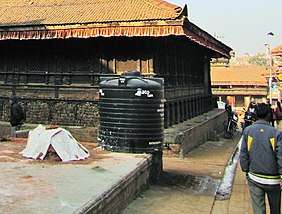Tutedhara
A tutedhara (Nepali) or jahru (Newari) is a traditional drinking fountain found in Nepal. It is a water reservoir built out of stone with a tap that can be opened and closed. These structures are either free-standing or integrated into the wall of another building. They depend on a water well or a dhunge dhara to be filled. Only a few of them are in use today, but some of the stone parts have been put to other uses, and there are contemporary equivalents. The best known tutedhara is the one built into a wall in the royal palace on Kathmandu Durbar Square. It is inscribed with a poem dedicated to the goddess Kali, written in fifteen different languages.
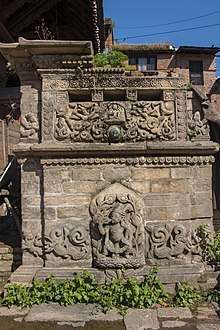
Etymology
The Nepali word tutedhara refers to the main feature of the drinking fountain: the tap that can be opened and closed. All the Newari names appear to be derived from the Sanskrit word jaladroni, meaning water bucket[1]: jarun, jahru, jadhun, jaldroni, jaladhenu, jalancha. Jarunhiti combines this with hiti, a term used for that other ancient drinking fountain: the hiti or dhunge dhara.[2][3][4]
History
Construction of water conduits like hitis, dug wells and jahru's are considered pious acts in Nepal. This applies to kings and other dignitaries as well as to ordinary citizens.[2][5][4][6]
What we know of the tutedhara comes from inscriptions that can sometimes be found on the stone. These don't always describe its creation, but some other dated event, indicating that the tutedhara would have already been in existence at that time. Such inscriptions have been found with dates up to the middle of the 19th century.[4]
One jahru in Khapinchhe in Patan shows an inscription dated 530 AD.[2] This is believed to be the oldest jahru in Nepal.[7] In Bhaktapur, the oldest jahru is dated 1175 AD.[6]
One of the oldest known inscriptions in the Newar language (1232 AD) is an inscription on a tutedhara.[2]
Only in the city of Patan has there been a comprehensive survey of all the tutedharas. A total of 106 of them have been found. A few of these had been kept operational in the traditional way and two were connected to the municipal water supply.[4]
Architecture
A tutedhara consists of (from the bottom to the top):
- a rectangular stone base;
- a rectangular pedestal made of stone or brick;
- a stone tank that can contain around 20 litres of water. On the back or the side of the tank there is a funnel to fill it. In the lower part of the tank on the front one or more spouts can be seen. The spouts can be opened or closed using a stopper;
- usually a lid made of stone or brick, sometimes with ornaments similar to the roof of a small temple.[3][4]
The front of the tank is sometimes decorated with symbols connected to water, like makaras. Below the spouts, there is almost always a relief depicting Bhagiratha, the mythical sage whose efforts helped bring the waters of the Ganges to earth.[8][3]
The sizes of the stone tanks vary considerably. The largest tank in Patan can hold 2,200 litres.[4]
Types
There are three main types of jahrus:[3][4]
- freestanding jahrus;
- jahrus connected to or integrated into the wall of another building, like a dharmasala (shelter or public resthouse), a monastery, a house or a gate;
- jahrus integrated into a dhunge dhara.
The first two types of jahru depend on an external source to be filled, so they are always found in the vicinity of a dhunge dhara or a well. Often, they are also close to a shelter of some kind, if they aren't actually built into one.[3][4] Freestanding jahrus are sometimes found in succession on important routes in the Kathmandu Valley. The way from Lele Village to Patan is an example of such a route.[4]
Traditionally, filling and cleaning the tutedharas was the work of the surrounding community, sometimes organised into a guthi (local community group dedicated to certain tasks), or the owner of the building the jahru was built into. Filling was done daily or as often as the tank would run dry.[4]
Maintenance would be done during special days, like Naga Panchami, Newar New Year and Sithi Nakha. Sithi Nakha is the day still used to clean water sources like wells, ponds, hitis and tutedharas.[5][4][9][10]
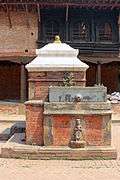 Nateswari Temple in Changu Narayan. The jahru has no lid.
Nateswari Temple in Changu Narayan. The jahru has no lid.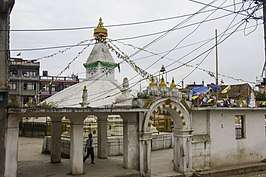 Gate to the Northern Ashok Stupa in Patan, with a built-in jahru on the right of the arch
Gate to the Northern Ashok Stupa in Patan, with a built-in jahru on the right of the arch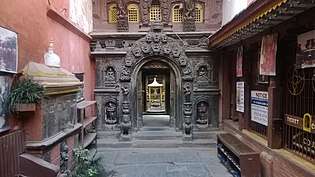 Entrance gate to the Golden Temple in Patan, with a jahru on the left
Entrance gate to the Golden Temple in Patan, with a jahru on the left- Jahru at Lakshmi Narayan Sattal (a dharmasala) in Kathmandu
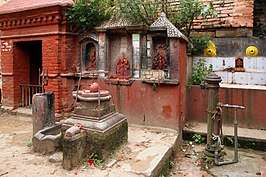 Some shrines in Bhaktapur with a disused jahru with two yellow spouts on the right
Some shrines in Bhaktapur with a disused jahru with two yellow spouts on the right
The third type of jahru does not need to be filled manually; the tank is filled by excess water that flows into the dhunge dhara. Cleaning and maintenance would likely be combined with the work on the hiti as a whole.[3][4]
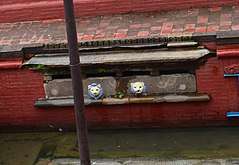 Jahru of Nag Bahal Hiti in Patan. The two spouts have the shape of a male and a female lion.
Jahru of Nag Bahal Hiti in Patan. The two spouts have the shape of a male and a female lion..jpg) Two jahrus can be seen in the walls of Tanga Hiti in Patan.
Two jahrus can be seen in the walls of Tanga Hiti in Patan..jpg) Sundhara in Patan. On the right side of the spout is the jahru.
Sundhara in Patan. On the right side of the spout is the jahru.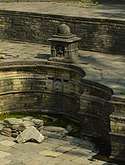 One of the two jahrus of Sundhara in Kathmandu
One of the two jahrus of Sundhara in Kathmandu.jpg) One of the two jahrus of Nag Pokhari hiti in Bhaktapur, with Bhagiratha beneath the spout
One of the two jahrus of Nag Pokhari hiti in Bhaktapur, with Bhagiratha beneath the spout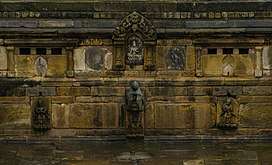 Two jahru's on either side of the stone spout at Bhandarkhal Pokhari in Patan
Two jahru's on either side of the stone spout at Bhandarkhal Pokhari in Patan
Royal inscriptions
The best known jahru is the one that was built into the white wall of the old royal palace on Kathmandu Durbar Square. This reservoir would be filled with water through holes that could be accessed from the inside of the courtyard. The water could be tapped from the outer wall.
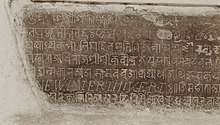
.jpg)
Father Giuseppe, an Italian Capuchin missionary, Prefect of the Roman Mission, described the jahru in 1799 in his "Account of the Kingdom of Nepal":[11]
In a wall of the royal palace of Cat'hmandu, which is built upon the court before the palace, there is a great stone of a single piece, which is about fifteen feet long, and four or five feet thick: on the top of this great stone there are four square holes at equal distances from each other. In the inside of the wall they pour water into the holes, and in the courtside, each hole having a closed canal, every person may draw water to drink. At the foot of the stone is a large ladder, by which people ascend to drink.
On the outside, the stone is inscribed with a poem dedicated to the goddess Kali, written in 15 different languages, including Nepali, Persian, French, Greek and Arabic. King Pratap Malla (1624-1674 AD), renowned for his linguistic abilities, set up this inscription in 1654. From the end of the 5th to the beginning of the 6th line the inscription reads: AVTOMNE WINTER L'HIVERT (French for autumn, Dutch, English or German for winter and French for winter). According to legend, people who could understand the poem would receive milk, instead of water, from the tutedhara.[2]
Close by, there are more tutedharas inscribed by Pratap Malla. These were already out of commission by 1654: eight stone tanks were used as steps to the Jagannath Temple.[4] These too carry poetry dedicated to Kali.[2]
Present state
.jpg)
Since the arrival of modern, piped water systems, starting in the late 19th century, most communities began to lose interest in their old drinking fountains, although, in Patan at least, many jahrus had been kept alive until far into the 20th century. Apart from a few exceptions, the jahrus and their function are now all but forgotten.[4]
In spite of that, ten tutedharas are listed as cultural heritage monuments of Nepal.[12]
Some jahrus were destroyed to make room for other buildings, but many of the solid stone tanks have been put to other uses. Kathmandu's Jagannath Temple is not the only place where old tanks are used as steps. The secondary stone steps on the north side of Krishna Mandir in Patan contain one old jahru among the stones, for example. One of the temples in the Bangalamukhi temple complex also has an old jahru as a stepping stone.[4]
Some of the old tanks function as a bench, a planter, a dustbin or a trough. In Patan, two are used for the pigeons on Durbar Square.[4] Something similar can be seen in Kathmandu.
Modern replacements
Although most jahrus may have lost their function, leaving only the stone remnants to posterity, new structures are taking their place: plastic water dispensers of different sizes, to be used by passersby. In Tripureswar, Kathmandu there is at least one case where not only the function but also the spirit of the jahru has been revived: the water is being given away for free.[4]
Water ATMs
In March 2019, the city of Lalitpur installed a 'water ATM' outside its office building. From this machine, people can buy small quantities (200 ml or 1 litre) of safe drinking water. This sparked a debate about whether or not dispensing water should be free of charge, as is tradition in Nepal.[13] At the beginning of 2020, the Kathmandu Valley Water Supply Management Board was planning to install 15 more water ATMs in busy places in the Kathmandu Valley, including some of the heritage sites. One of the stated aims was to reduce the use of plastic water bottles.[14]
References
- Sanskrit-English / English-Sanskrit Dictionary for Spoken Sanskrit, retrieved 9 March 2020
- Nepal Mandala: A Cultural Study of the Kathmandu Valley, Text. 1 by Mary Shepherd Slusser, Princeton University Press, 1982, retrieved 1 March 2020
- Water Conduits in the Kathmandu Valley (2 vols.) by Raimund O.A. Becker-Ritterspach, ISBN 9788121506908, Published by Munshiram Manoharlal Publishers Pvt. Ltd., New Delhi, India, 1995
- Jarunhiti by Akira Furukawa (ed.), Sukra Sagar Shrestha, Amrit Bajracharya and Kanako Ogasawara, Vajra Books, Nepal, 2010, ISBN 9789937506533
- UN-HABITAT, 2007. Water Movement in Patan with reference to Traditional Stone Spouts, ISBN 9789937203913
- Construction of Traditional Water Supply System in Bhaktapur by Sudarshan Raj Tiwari, 2014, retrieved 10 March 2020
- Disaster Risk Management for the Historic City of Patan, Nepal by Rits-DMUCH, Ritsumeikan University, Kyoto, Japan and Institute of Engineering, Tribhuvan University, Kathmandu, Nepal, 2012, retrieved 16 September 2019
- Nepal Mandala A Cultural Study of the Kathmandu Valley, Vol. 2 Plates by Mary Shepherd Slusser, Princeton University Press, 1982, retrieved 11 March 2020
- Sithi Nakha celebrated in valley, The Himalayan Times, 9 June 2019, retrieved 20 March 2020
- Sithi Nakha, Traditional way of Celebrating Environment Day by Monalisa Maharjan, ICHCAP, 4 July 2018, retrieved 21 March 2020
- Account of the Kingdom of Nepal by Father Giuseppe in Asiatic Researches, Volume 2, p. 313, Asiatick Society, Calcutta, India, reprinted for Vernor and Hood, 1799, retrieved 7 February 2020
- A Wikipedia search yields six items listed as jaldroni, two as jaladroni and one as jaladhenu
- Public and city planners welcome government’s ‘Water ATM’ service, but demand it free of charge by Anup Ojha, The Kathmandu Post, 9 March 2019, retrieved 12 March 2020
- Water ATMs to be set up across valley by CK Khanal, The Rising Nepal, 15 January 2020, retrieved 12 March 2020
External links

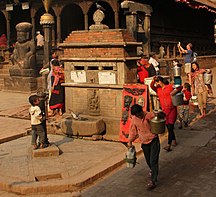
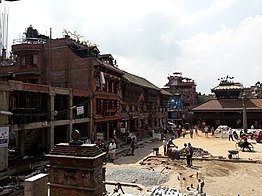
.jpg)
